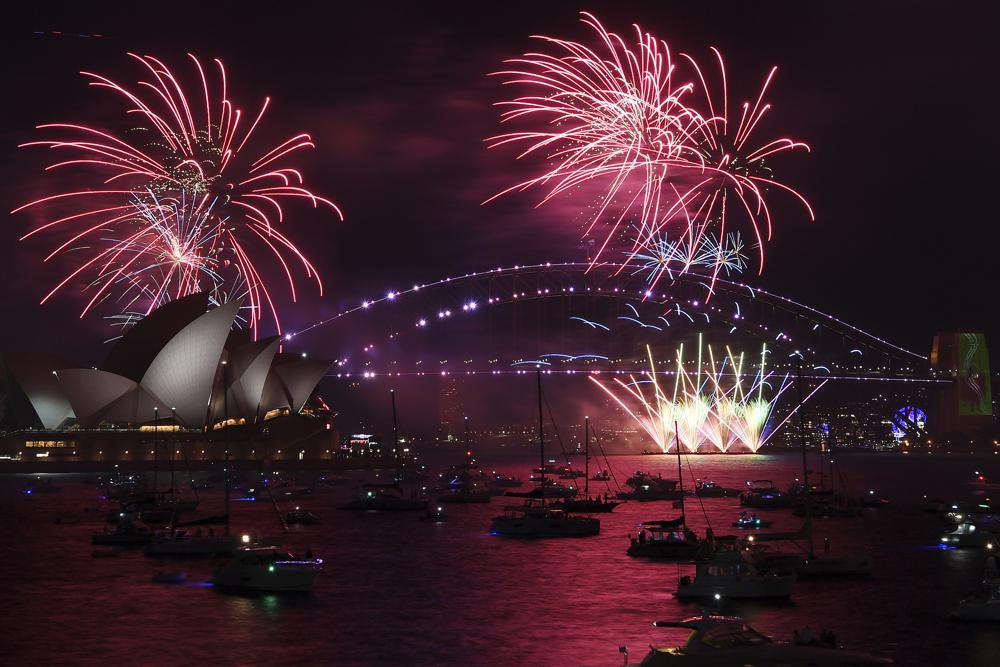
Good riddance to 2021. Let 2022 bring fresh hope.
That was a common sentiment as people around the world began welcoming in the new year.
In many places, New Year’s Eve celebrations were muted or canceled for the second straight year due to a surge of coronavirus infections, this time driven by the highly contagious omicron variant.
Even before omicron hit, many people were happy to say goodbye to a second grinding year of the pandemic.
But so far, at least, the omicron surge hasn’t resulted in the same levels of hospitalizations and deaths as previous outbreaks — especially among vaccinated people — offering a glimmer of hope for 2022.
New Zealand was one of the first places to celebrate the new year with a low-key lights display projected onto Auckland landmarks, including the Sky Tower and Harbor Bridge. That replaced the traditional fireworks show. While there hasn’t yet been any community spread of omicron in New Zealand, authorities still wanted to discourage crowds gathering.
Neighboring Australia, however, was going ahead with its celebrations despite an explosion in virus cases. Some fireworks were let off early in the evening to give younger children a preview of the centerpiece of festivities, the renowned fireworks display from the Sydney Harbor Bridge and Sydney Opera House.
Hours before the celebrations began, Australian health authorities reported a record 32,000 new virus cases, many of them in Sydney. Because of the surge, crowds were far smaller than in pre-pandemic years, when as many as 1 million revelers would crowd inner Sydney.

Because of where the international date line sits, countries in Asia and the Pacific region are among the first to usher in each new year.
In Japan, writer Naoki Matsuzawa said he would spend the next few days cooking and delivering food to the elderly because some stores would be closed. He said vaccinations had made people less anxious about the pandemic, despite the new variant.
“A numbness has set in, and we are no longer overly afraid,” said Matsuzawa, who lives in Yokohama, southwest of Tokyo. “Some of us are starting to take for granted that it won’t happen to me.”
Like many other people, Matsuzawa hopes that life will improve in 2022.
“I hope the restrictions can disappear,” he said.
Across Japan, many people planned to take new year trips to spend time with their families. On New Year’s Eve, people thronged temples and shrines, most of them wearing masks.
Some appeared to be shrugging off virus fears, however, by dining and drinking raucously in downtown Tokyo and flocking to shops, celebrating not only the holidays but a sense of exhilaration over being freed from recent virus restrictions.

In South Korea’s capital, Seoul, the annual New Year’s Eve bell-ringing ceremony was canceled for the second straight year due to a surge in cases.
Officials said a pre-recorded video of this year’s bell-ringing ceremony would instead be broadcast online and on television. The ceremony had previously drawn tens of thousands of people. Last year’s cancellation was the first since the ceremony began in 1953.
South Korean authorities also planned to close many beaches and other tourist attractions along the east coast, which usually swarm with people hoping to catch the year’s first sunrise. On Friday, South Korea said it will extend tough distancing rules for another two weeks.
In India, millions of people were planning to ring in the new year from their homes, with nighttime curfews and other restrictions taking the fizz out of celebrations in large cities including New Delhi and Mumbai.
Authorities have imposed restrictions to keep revelers away from restaurants, hotels, beaches and bars amid a surge in cases fueled by omicron.
But some places, including Goa, a tourist paradise, and Hyderabad, an information technology hub, have been spared from night curfews thanks to smaller numbers of infections, although other restrictions still apply.
Many Indonesians were also forgoing their usual festivities for a quieter evening at home, after the government banned many New Year’s Eve celebrations. In Jakarta, fireworks displays, parades and other large gatherings were prohibited, while restaurants and malls were allowed to remain open but with curfews imposed.
Vietnam also canceled fireworks shows and celebrations. In Hanoi, authorities closed off central streets, while in Ho Chi Minh City, audiences were banned from watching live countdown performances, which instead were to be shown on social media.
In Hong Kong, about 3,000 people planned to attend a New Year’s Eve concert featuring local celebrities including boy band Mirror. The concert will be the first big New Year’s Eve event held since 2018, after events were canceled in 2019 due to political strife and last year because of the pandemic.
In mainland China, the Shanghai government canceled events including an annual light show along the Huangpu River in the city center that usually draws hundreds of thousands of spectators.

There were no plans for public festivities in Beijing, where popular temples have been closed or had limited access since mid-December. The government has called on people to avoid leaving the Chinese capital if possible and requires tests for travelers arriving from areas where there are infections.
Popular temples in the eastern Chinese cities of Nanjing, Hangzhou and other major cities canceled traditional New Year’s Eve “lucky bell-ringing” ceremonies and asked the public to stay away.
But in Thailand, authorities were allowing New Year’s Eve parties and fireworks displays to continue, albeit with strict safety measures. They were hoping to slow the spread of the omicron variant while also softening the blow to the country’s battered tourism sector. New Year’s Eve prayers, which are usually held in Buddhist temples around Thailand, will be held online instead.
In the Philippines, a powerful typhoon two weeks ago wiped out basic necessities for tens of thousands of people ahead of New Year’s Eve. More than 400 were killed by Typhoon Rai and at least 82 remain missing. Half a million homes were damaged or destroyed.
Leahmer Singson, a 17-year-old mother, lost her home to a fire last month, and then the typhoon blew away her temporary wooden shack in Cebu city. She will welcome the new year with her husband, who works in a glass and aluminum factory, and her 1-year-old baby in a ramshackle tent in a coastal clearing where hundreds of other families erected small tents from debris, rice sacks and tarpaulins to shield themselves from the rain and sun.
Asked what she wants for the new year, Singson had a simple wish: “I hope we won’t get sick.”

















